Study Guide
Section 7: RICA Written Examination Subtest 2
Sample Multiple-Choice Questions
Expand All Answers | Collapse All Answers
Domain 4—Vocabulary, Academic Language, and Background Knowledge
Competency 10—Understand the role of vocabulary, academic language, and background knowledge in reading development and factors that affect students' development of vocabulary, academic language, and background knowledge.
1. Lately, when choosing a book to read, a third grader who reads at grade level always selects books from a series that is written in a very formulaic style that does little to extend his conceptual or language development. The teacher's best response to this behavior would be to:
- avoid interfering with the student's selection of books as long as he finds his choices enjoyable.
- provide the student with books with similar themes or on similar topics that are more challenging for him.
- point out to the student some of the major limitations of the books he is choosing to read and ask him not to read those books at school.
- advise the student that he should choose books that will prepare him for the more difficult reading he will encounter in fourth grade.
- Enter to expand or collapse answer.Answer expanded
- Option B is correct.
Competency 10—Understand the role of vocabulary, academic language, and background knowledge in reading development and factors that affect students' development of vocabulary, academic language, and background knowledge.
2. A second-grade student has limited vocabulary knowledge, which hinders the student's word recognition and reading comprehension. The student's oral reading is slow and labored, and the student typically spends the majority of independent reading time browsing through books, making little effort to read the actual words on the page. Research has shown that which of the following is most likely to happen if this student receives no instructional intervention?
- The student will always be behind average-performing peers but will achieve an adequate reading level to be academically successful.
- The student will naturally begin to show more interest and proficiency in reading as the student matures and will catch up with average-performing peers in third grade.
- The student will remain approximately at a second-grade reading level and will not be able to progress beyond this level.
- The student will begin to fall behind peers in reading development and will continue to fall further behind in later grades as texts include increasingly difficult vocabulary.
- Enter to expand or collapse answer.Answer expanded
- Option D is correct.
Competency 10—Understand the role of vocabulary, academic language, and background knowledge in reading development and factors that affect students' development of vocabulary, academic language, and background knowledge.
3. Which of the following statements best explains an important limitation of teaching students to rely on context as their primary strategy for determining the meaning of unfamiliar words in texts?
- Context clues have limited usefulness for students who already have well-developed background knowledge related to a text's subject or content.
- Using context to determine the meaning of an unfamiliar word disrupts students' reading fluency more significantly than simply consulting a dictionary.
- Explicit context clues about a word's meaning are not very common in most texts, while implicit contextual clues often require students to apply background knowledge they lack.
- Overreliance on context as a word-learning strategy hinders students' vocabulary growth, since they should be learning most new words in direct vocabulary instruction.
- Enter to expand or collapse answer.Answer expanded
- Option C is correct.
Competency 10—Understand the role of vocabulary, academic language, and background knowledge in reading development and factors that affect students' development of vocabulary, academic language, and background knowledge.
4. A fifth-grade teacher is planning a multidisciplinary unit on water pollution. For this unit, students will read chapters from their social studies and science textbooks as well as relevant fictional narratives. These materials will also be incorporated into a variety of instructional activities designed to promote students' reading development. Which of the following statements best describes an important advantage of using a cross-curricular approach such as this unit to promote students' reading development?
- Interdisciplinary reading instruction provides more opportunities for teachers to tailor teaching strategies to the needs of individual students.
- Reading instruction that focuses on both literature and content-area texts helps students recognize and understand differences between written and oral English.
- Interdisciplinary reading instruction motivates students to apply a variety of word identification strategies to clarify the meaning of texts.
- Reading instruction that integrates a variety of related texts promotes deep processing of new vocabulary through multiple exposures to key words and concepts.
- Enter to expand or collapse answer.Answer expanded
- Option D is correct.
Competency 10—Understand the role of vocabulary, academic language, and background knowledge in reading development and factors that affect students' development of vocabulary, academic language, and background knowledge.
5. A middle school teacher writes the morpheme dict on the board, pronounces it, and explains that dict derives from the Latin word for "speak." The teacher then asks students if they can think of English words that start with or include dict. The teacher uses the students' suggestions to create the diagram shown below.
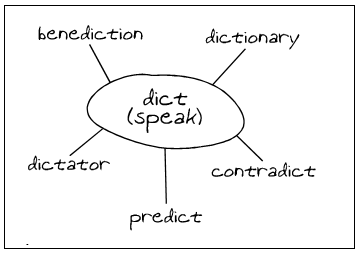
A web diagram with an oval in the center labeled dict open parens speak close parens. Lines extend out from the oval to the following five English words: benediction, dictionary, contradict, predict, dictator.
This activity is likely to promote students' vocabulary development primarily by helping the students:
- recognize common prefixes and suffixes.
- learn the techniques of concept mapping.
- apply knowledge of word roots as a word-learning strategy.
- draw on a knowledge of phonics to unlock word meanings.
- Enter to expand or collapse answer.Answer expanded
- Option C is correct.
Competency 11—Understand how to promote students' development of vocabulary, academic language, and background knowledge.
6. A teacher substitutes blank spaces for several nouns, verbs, adjectives, and adverbs in an appropriate level text and asks students to determine reasonable and logical words to complete each blank. This technique is useful as an informal assessment of students' understanding of English language structures primarily because it requires them to:
- define various grammatical categories in their own words.
- select appropriate words based on their grammatical function as well as on their meaning.
- group words into grammatical categories to clarify their meaning.
- draw on grammatical knowledge to identify the subjects and predicates of complex sentences.
- Enter to expand or collapse answer.Answer expanded
- Option B is correct.
Competency 11—Understand how to promote students' development of vocabulary, academic language, and background knowledge.
7. A fifth-grade teacher gives students the following sentence:
Neither walking on the beach nor running around the track cheered Ahmed up.
The teacher asks the students how the phrases that come just after neither and just after nor are similar. This exercise can promote students' reading comprehension by helping them:
- distinguish between explicit and implied main ideas.
- apply literal comprehension skills.
- identify cause-and-effect relationships.
- recognize parallel grammatical structures.
- Enter to expand or collapse answer.Answer expanded
- Option D is correct.
Competency 11—Understand how to promote students' development of vocabulary, academic language, and background knowledge.
8. A middle school teacher designs an instructional activity in which students combine several sentences to form a single sentence, as illustrated below.
Combine
Matthew stood and waited for the bus.
The sun was blazing hot.
Matthew fanned himself with the newspaper.Single sentence:
Waiting for the bus, Matthew stood in the blazing sun, fanning himself with the newspaper.
This activity is likely to be most effective in helping students:
- strengthen their ability to comprehend and write complex sentences.
- apply literal comprehension skills to identify and write main idea statements.
- improve their inferential comprehension skills.
- use self-monitoring techniques to clarify the meaning of text.
- Enter to expand or collapse answer.Answer expanded
- Option A is correct.
Competency 11—Understand how to promote students' development of vocabulary, academic language, and background knowledge.
9. Structural analysis would be the most appropriate strategy for a student to use to determine the meaning of which of the following words?
- impassable
- elephant
- interim
- examine
- Enter to expand or collapse answer.Answer expanded
- Option A is correct.
Domain 5—Comprehension
Competency 13—Understand how to facilitate reading comprehension by providing instruction that prepares students for the reading task, scaffolds them as needed through the reading process, and prepares them to respond to what they have read.
10. To promote students' comprehension of a passage about comets and meteoroids, a middle school teacher shows the students how to use facts from the text to complete the following Venn diagram.
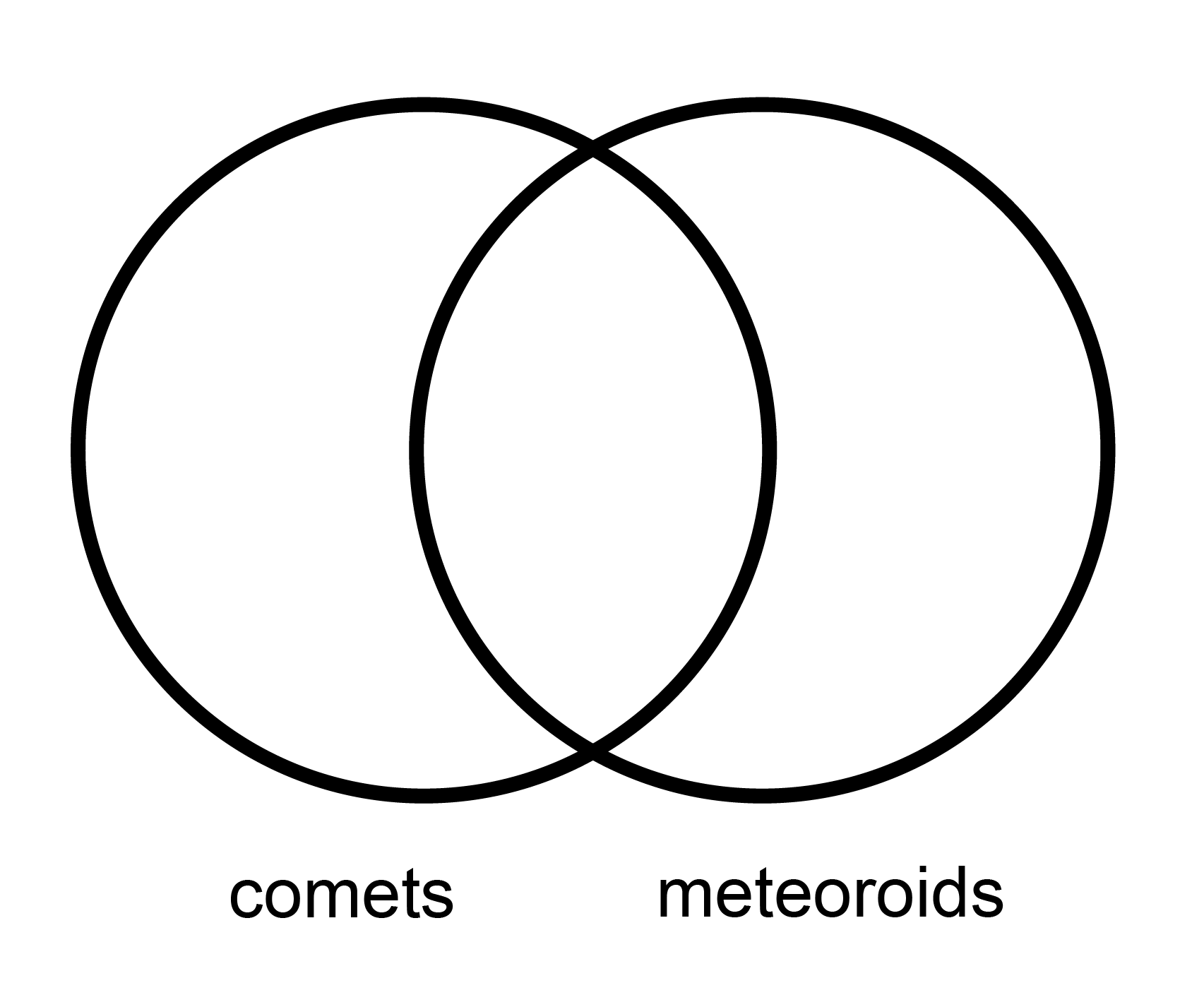
A Venn diagram containing two overlapping circles that are labeled comets and meteoroids.
This comprehension strategy is most effective in facilitating students' ability to:
- use inferential comprehension skills to identify cause-and-effect relationships.
- draw on their prior knowledge to clarify understanding.
- organize textual information according to similarities and differences.
- apply their vocabulary knowledge in new contexts.
- Enter to expand or collapse answer.Answer expanded
- Option C is correct.
Competency 13—Understand how to facilitate reading comprehension by providing instruction that prepares students for the reading task, scaffolds them as needed through the reading process, and prepares them to respond to what they have read.
11. A third-grade teacher prepares several poster-sized copies of the star diagram illustrated below.
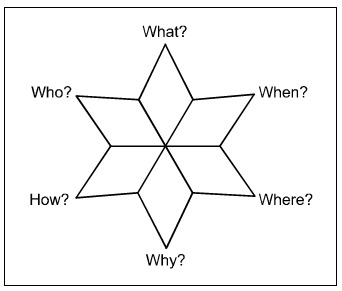
Six-pointed star diagram. Points are labeled: Who? What? When? Where? Why? How?
After reading an assigned story, students divide into small groups, and the teacher distributes a copy of the star diagram to each group. The members of each group discuss how the six questions (who, what, when, where, why, and how) apply to the story and write answers in the six points of the star. The teacher then displays the completed star diagrams and leads a whole-class discussion about them. This instructional activity is most likely to promote students' reading proficiency in which of the following ways?
- improving students' comprehension by encouraging them to analyze a text's underlying theme
- helping students learn a strategy for using visual representation to analyze key elements of a text
- improving students' comprehension by encouraging them to connect personal experience to a text
- helping students learn to use evaluative comprehension skills to determine an author's point of view
- Enter to expand or collapse answer.Answer expanded
- Option B is correct.
Competency 14—Understand how to promote students' comprehension and analysis of narrative/literary texts and their development of literary response skills.
12. An eighth-grade class will be reading a drama that is a challenging grade-level text. The teacher is concerned that a student in the class who has a reading disability will have difficulty keeping up with and understanding the reading assignments. Which of the following strategies would be most effective for the teacher to use to promote the student's access to the text and his ability to participate fully in class discussions related to it?
- assigning the student the play several weeks before his classmates are scheduled to begin reading it
- providing the student with a narrative version of the play to read rather than the original, dramatic version
- assigning the student only selected portions of the play, such as a few key speeches and dialogues
- providing the student with an audiorecording of the play to listen to in conjunction with his reading
- Enter to expand or collapse answer.Answer expanded
- Option D is correct.
Competency 14—Understand how to promote students' comprehension and analysis of narrative/literary texts and their development of literary response skills.
13. A first-grade teacher plans to assess a student's comprehension of a short story through oral retelling. After the student silently reads the story, the teacher will prompt the student's retelling by asking open-ended questions. To prepare for this assessment, the teacher reads the story carefully and composes the questions. Which of the following additional steps would be most helpful for the teacher to take before the retelling activity begins?
- Prompt the student to recall similar tasks the student has previously performed.
- Prepare a checklist of the key elements that an effective retelling of this story should include.
- Review grades earned by the student on recent tests and quizzes in language arts.
- Remind the student to concentrate on recalling as many details as possible during the retelling.
- Enter to expand or collapse answer.Answer expanded
- Option B is correct.
Competency 14—Understand how to promote students' comprehension and analysis of narrative/literary texts and their development of literary response skills.
14. A fifth-grade teacher is teaching a unit on fiction. To begin, students read several simple fairy tales and discuss the moral or meaning of each one. The teacher then assigns a more complex story and leads a discussion about the moral of the story after students finish reading it. This instructional strategy is most likely to promote students' reading proficiency by:
- guiding students to analyze the relationship between plot and character in a literary text.
- helping students identify and understand the theme of a literary text.
- fostering students' ability to distinguish an author's use of fact versus opinion in a text.
- enhancing students' ability to use self-monitoring strategies to clarify the meaning of a text.
- Enter to expand or collapse answer.Answer expanded
- Option B is correct.
Competency 15—Understand how to promote students' comprehension of expository/informational texts and their development of study skills and research skills.
15. A sixth-grade teacher has students read a short expository text. After the students finish reading the text, the teacher uses guided discussion to help them complete the form shown below.
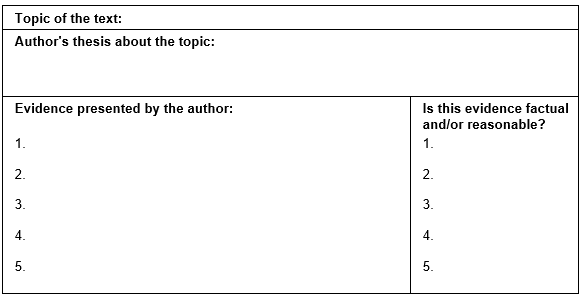
A blank form that asks for the following information: First row, Topic of the text. Second row, Author's thesis about the topic. Third row, first column, five pieces of Evidence presented by the author. Third row, second column, is each piece of Evidence in the previous column factual and or reasonable?
This writing activity promotes students' comprehension and analysis of expository texts primarily by:
- developing their ability to evaluate the adequacy of an author's conclusions.
- teaching them explicit strategies for distinguishing facts from opinions.
- encouraging them to identify ways in which a text reflects the traditions and beliefs of its author.
- helping them clarify their understanding of a text through the use of outlines.
- Enter to expand or collapse answer.Answer expanded
- Option A is correct.
Use the information below to answer the two questions that follow.
A fourth-grade class is beginning a unit on deserts. The teacher starts the unit by having the students form small groups and list everything they know about deserts. Then the whole class meets to share their lists, and the teacher helps the students arrange their ideas into a web. The class's partially completed web is shown below.
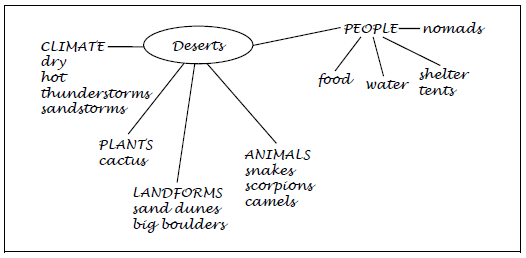
A Web diagram with an oval labeled Deserts. Five lines extend out with category labels and related words. The category climate includes the following words: dry, hot, thunderstorms, sandstorms. The category plants includes the word cactus. The category landforms includes the following terms: sand dunes, big boulders. The category animals includes the following words: snakes, scorpions, camels. The category people includes the following words: nomads, food, water, shelter, tents.
Competency 15—Understand how to promote students' comprehension of expository/informational texts and their development of study skills and research skills.
16. Creating such a web is likely to promote students' ability to retain and use information they read about a topic by:
- encouraging students to attend to new information on the topic rather than to familiar information.
- providing students with the vocabulary they need to make sense of their reading.
- prompting students to assess the accuracy of their prior knowledge of the topic.
- helping students learn to use categories to organize their thinking about the topic.
- Enter to expand or collapse answer.Answer expanded
- Option D is correct.
Competency 13—Understand how to facilitate reading comprehension by providing instruction that prepares students for the reading task, scaffolds them as needed through the reading process, and prepares them to respond to what they have read.
17. After giving each student a copy of the web developed by the class, the teacher could best help students make use of the web to learn and retain facts from their reading by asking them to:
- add continuously to the web as they encounter and analyze new information in their reading.
- compare the content of this web to the content of webs on other topics.
- review each category on the web to ensure that it is an appropriate one to have included.
- memorize the information on the web before they begin their reading
- Enter to expand or collapse answer.Answer expanded
- Option A is correct.
Multiple-Domain Passages
Use the information below to answer the four questions that follow.
A sixth-grade teacher reads his students the nonsense poem "Jabberwocky" by Lewis Carroll. The first four lines of the poem are shown below.
'Twas brillig, and the slithy toves
Did gyre and gimble in the wabe;
All mimsy were the borogoves,
And the mome raths outgrabe.
Competency 12—Understand literal, inferential, and evaluative comprehension and factors affecting reading comprehension.
18. The teacher reads aloud the clause "All mimsy were the borogoves" and asks students what that might mean. One student responds, "It means that the borogoves were all mimsy!" This student's response demonstrates skill in which of the following reading comprehension strategies?
- applying relevant content knowledge
- recognizing cause-and-effect relationships.
- analyzing the use of figurative language
- interpreting unusual grammatical constructions
- Enter to expand or collapse answer.Answer expanded
- Option D is correct.
Competency 11—Understand how to promote students' development of vocabulary, academic language, and background knowledge.
19. The teacher plans a variety of activities related to "Jabberwocky." Students will work in pairs to make up definitions for some of the nonsense words (e.g., slithy). They will read the poem aloud using tone of voice to express various moods. Finally, they will create their own nonsense poems and give oral readings of them. These activities are most likely to promote students' reading development by:
- providing students with the opportunity for an in-depth analysis of a specific literary genre.
- developing students' understanding of the differences between written and oral English.
- fostering students' enjoyment of playing with and thinking about language.
- helping students make distinctions between serious and whimsical literature.
- Enter to expand or collapse answer.Answer expanded
- Option C is correct.
Competency 11—Understand how to promote students' development of vocabulary, academic language, and background knowledge.
20. One student pronounces gyre with a hard g sound, while his classmate uses a soft g sound. They ask the teacher who is correct. The teacher's best response would be to:
- remind students to use their knowledge of syntactic principles to determine the pronunciation.
- explain that one strategy for determining a likely pronunciation of a new word is to consider other words that contain a similar root (e.g., gyrate, gyroscope).
- have the class vote and suggest that students use the pronunciation that is preferred by the majority.
- advise them that since gyre is a nonsense word, it does not really matter whether they pronounce it with a hard g or a soft g, so both pronunciations are correct.
- Enter to expand or collapse answer.Answer expanded
- Option B is correct.
Competency 11—Understand how to promote students' development of vocabulary, academic language, and background knowledge.
21. The teacher asks the students if they can tell which of the nonsense words in the poem are nouns. One student says that toves is a noun. Another says that wabe and borogoves are nouns and adds that gyre and gimble are verbs. The class then discusses how students were able to draw these conclusions. This exercise would be especially useful for helping students understand that:
- being familiar with conventions of capitalization and spelling can help a reader interpret a text.
- recognizing the roots of words can help a reader decode the words.
- being familiar with common language structures can help a reader interpret a text.
- recognizing a text's genre can help a reader comprehend the text.
- Enter to expand or collapse answer.Answer expanded
- Option C is correct.
Use the information below to answer the three questions that follow.
A sixth-grade class that includes several English Learners has been studying volcanoes. The teacher designs the following paragraph-building activity as part of a chapter review toward the end of the unit.
Step 1: The teacher leads a brief whole-class discussion reviewing key topics covered by the textbook chapter.
Step 2: Students form heterogeneous cooperative learning groups with three or four students in each group. Each of the students selects one of the key topics reviewed during the discussion.
Step 3: Individual students write one or two sentences about their topic on sentence strips.
Step 4: The members of the group then decide how to put the various sentences together, editing the sentences as necessary to form a comprehensible paragraph about the chapter and correcting any errors in grammar or spelling.
After participating in this activity, all of the students review the chapter in their science text about volcanoes.
Competency 11—Understand how to promote students' development of vocabulary, academic language, and background knowledge.
22. The paragraph-building activity described is likely to promote students' reading development primarily by helping them:
- apply knowledge of common text structures to improve comprehension as they read.
- transfer skills from oral language to written language.
- use a variety of word identification strategies.
- understand differences between spoken and written English.
- Enter to expand or collapse answer.Answer expanded
- Option B is correct.
Competency 12—Understand literal, inferential, and evaluative comprehension and factors affecting reading comprehension.
23. After assessing the effectiveness of this activity, the teacher decides to include an additional step. For step 5, the teacher will guide students to develop topic sentences for the paragraphs they generated. This modification is most likely to promote students' reading development by:
- encouraging students to draw on prior knowledge to clarify their understanding as they read.
- helping students distinguish between facts and opinions as they read.
- encouraging students to apply vocabulary knowledge in new contexts.
- helping students recognize main ideas and how supporting details relate to main ideas.
- Enter to expand or collapse answer.Answer expanded
- Option D is correct.
Competency 15—Understand how to promote students' comprehension of expository/informational texts and their development of study skills and research skills.
24. Which of the following best describes one important way in which this activity is likely to benefit English Learners?
- Arranging sentences in a meaningful order helps English Learners develop skills for locating and retrieving related information from content-area texts.
- Combining sentences into paragraphs encourages English Learners to employ a variety of word identification strategies.
- Discussing and writing about a content-area topic support English Learners' reading related to the topic by reinforcing key concepts and academic-language development.
- Analyzing and editing individual sentences improve English Learners' reading fluency by helping them chunk text as they read.
- Enter to expand or collapse answer.Answer expanded
- Option C is correct.